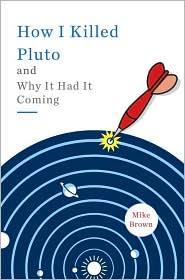Top Qs
Timeline
Chat
Perspective
How I Killed Pluto and Why It Had It Coming
Book by Michael E. Brown From Wikipedia, the free encyclopedia
Remove ads
How I Killed Pluto and Why It Had It Coming is the 2010 memoir by Mike Brown, the American astronomer most responsible for the reclassification of Pluto from planet to dwarf planet.[1][2]
Summary
Summarize
Perspective
The memoir is an account of the events surrounding the redefinition of the term planet that eventually changed the status of Pluto.
Brown recounts his professional career as a faculty member at the California Institute of Technology leading a team which examined large patches of the sky in an attempt to identify and track Trans-Neptunian objects.

In the mid to late 1990's, the team utilizes analog plates (in the same way as Clyde Tombaugh discovered Pluto in 1930), a painstaking process, which did not yield good results.
The team progresses to computer software and digital scanning technology, writing code to automatically identify patches of sky with moving stars. Initial iterations of the software identified many false positives due to smudges and light artifacts.
Into the early 2000's, the team is successful in finding a series of Kuiper belt objects.
The first, dubbed "Object X" (Quaoar) is discovered in 2002. A year later, Brown's team finds more objects, which the team dubs "Santa" (Haumea) and "Easter Bunny" (Makemake) as they were discovered close to the holidays.

Brown's team intends to keep the discoveries a secret until they had surveyed them for several months and were able to write a formal scientific paper on each of them. This is in order to avoid misleading the public about the materials and size of the planets, as each one they had found up to then was thought to be larger than Pluto at first - only for size measurements to be refined down due to brighter-than-expected surface materials.
However, NASA researchers (who had to be contacted in order to arrange for Hubble operation time) plan to announce the discoveries at an upcoming conference.
A team of astronomers at the Sierra Nevada Observatory in Spain led by José Luis Ortiz Moreno, finds NASA's conference agenda, track down the object using a publicly-available repository of the sky pictures used by Brown's team - and publish the discovery as their own. Brown initially allows them to take credit for it, but swiftly changes his mind.
Against his original desire, Brown and his team schedule public press conferences and interviews about their work, releasing information about Makemake, Haumea and a new discovery, Xena (Eris).
Brown also recounts his personal life, speaking about his wife Diane's role in consoling and advising him, along with the birth of his daughter Lilah in 2005, at the same time his team was rushing to complete reports on Eris.
Eris was mistakenly thought to be larger than Pluto, causing many to suggest it may be the 10th planet. However, Brown himself dismisses this notion, stating that neither Pluto nor Eris should be considered planets due to their size difference with the rest of the Solar System objects. He also cites that shortly after Ceres and Vesta were discovered in the 1800's, those were also considered planets until being reclassified as asteroids.

In 2006, after much tedious argument about the definition of the term planet, the International Astronomical Union schedules a vote that removes Pluto from the list of Solar System planets. Pluto, Eris and all the objects that Brown's team discovered are renamed dwarf planets.
Remove ads
Reviews
Reviews of the book have been generally positive, with James Kennedy of The Wall Street Journal calling the book a "brisk" and "enjoyable ... chronicle" of the tale of the search for new planets and the eventual demotion of Pluto from planetary status.[3] Janet Maslin of The New York Times called it a "short, eager-to-please research memoir".[4]
See also
References
Bibliography
Wikiwand - on
Seamless Wikipedia browsing. On steroids.
Remove ads

